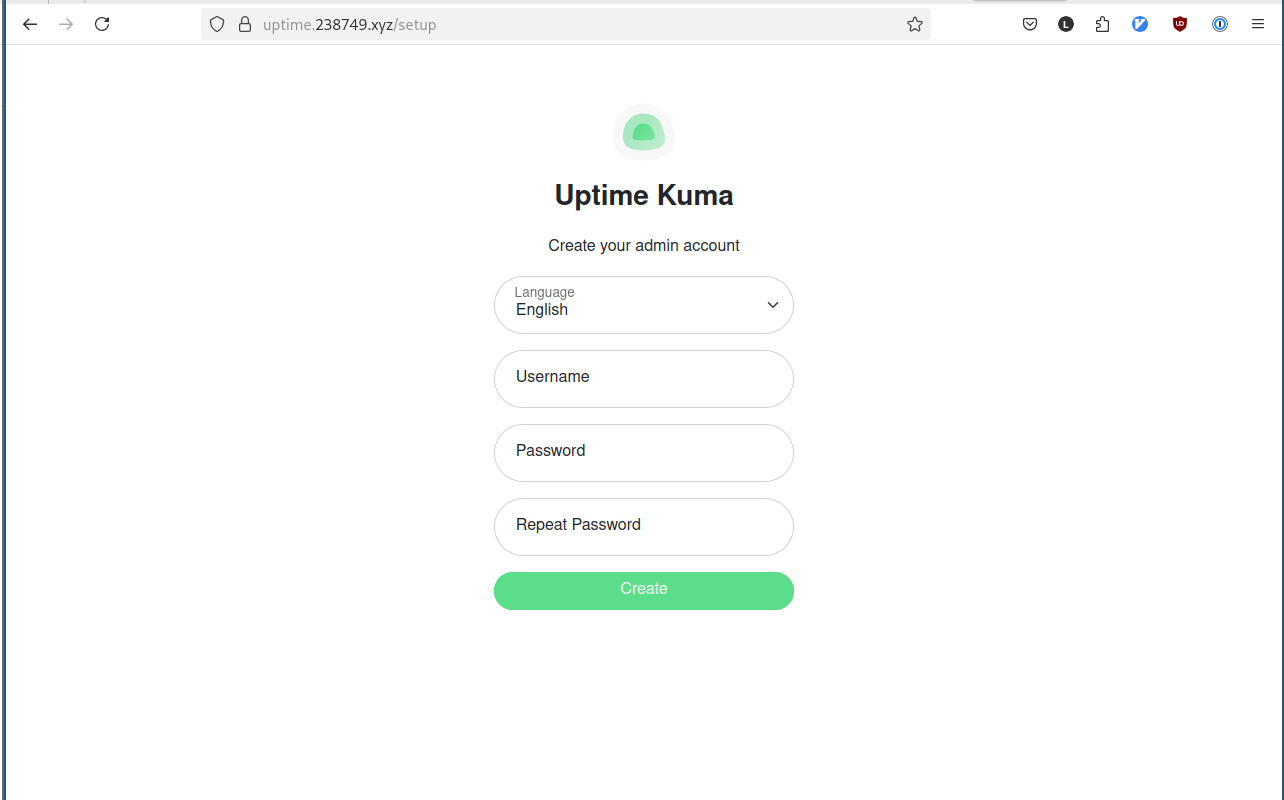Add more services
You can include any docker-compose.yaml file in your apps directory if you want to inlude it in the stack. There are some steps you will need to be aware you need to do in order to run properly.
You will have to:
- update the root docker-compose.yaml to include the new
docker-composefile. - Update the volumes of the docker-compose to point to a path under
/mnt/dataif you want your data to be persistant. - Add the containers to the
private_networkso is in the same network as the other containers. - Add the traefik labels if you want to expose your service.
- Add the docker-volume-backup labels if you want the container to be stopped when the backup is taken
- Include the
.secretsfile, if you want to read the secrets from infisical an environment variables.
A very good starting point to find docker-compose.yaml files for almost any service you want to self host is the awesome-selfhosted repository.
As an example let's say we want to deploy uptime-kuma based on the docker-compose.yaml as found in uptime github repository.
services:
uptime-kuma:
image: louislam/uptime-kuma:1
volumes:
- ./data:/app/data
ports:
# <Host Port>:<Container Port>
- 3001:3001
restart: unless-stopped
We need first to place this file under containers-host/apps/uptime/docker-compose.yaml file. The new structure should look now like:
├── docker-compose.yaml
├── .env
├── traefik
│ └── docker-compose.yaml
├── uptime
│ └── docker-compose.yaml
└── docker-backup
└── docker-compose.yaml
update the root docker-compose
version: "3"
include:
- ./traefik/docker-compose.yaml
- ./docker-backup/docker-compose.yaml
# Add the line below to include the uptime-kuma docker-compose
- ./uptime/docker-compose.yaml
networks:
private_network:
name: private_network
driver: bridge
ipam:
config:
- subnet: 172.29.1.0/24
Update the volumes
The config volume is the one we want to store in the persistant data. So we are going to update the docker-compose.yaml to look like:
services:
uptime-kuma:
image: louislam/uptime-kuma:1
volumes:
- /mnt/data/uptime:/app/data
ports:
# <Host Port>:<Container Port>
- 3001:3001
restart: unless-stopped
Update Network
We need to update the network so uptime-kuma container is running in the same network with the rest containers.
services:
uptime-kuma:
image: louislam/uptime-kuma:1
volumes:
- /mnt/data/uptime:/app/data
ports:
# <Host Port>:<Container Port>
- 3001:3001
networks:
- private_network
restart: unless-stopped
Add the traefik labels
To configure Traefik to route HTTPS traffic to the uptime-kuma service based on the specified host (uptime.your-domain), while also managing TLS certificates automatically through Let's Encrypt we need to add the following labels:
traefik.enable: This label enables Traefik for the uptime-kuma service. If this label is set to false, Traefik will ignore this service.
traefik.http.routers.uptime.entrypoints: This label specifies that the router for this service should listen on the websecure entry point.
traefik.http.routers.uptime.rule: It tells Trafik which domain requests to route to uptime-kuma services. If ${DOMAIN} is example.com, then is going to route all requests to uptime.example.com to uptime-kuma service
traefik.http.routers.uptime.tls.certresolver: This label indicates which resolved Traefik should use to automatically obtain and manage TLS certificates for this service.
traefik.http.routers.uptime.tls: If true it explicitly enables TLS for the router, ensuring that the service is served over HTTPS.
services:
uptime-kuma:
image: louislam/uptime-kuma:1
labels:
- "traefik.enable=true"
- "traefik.http.routers.uptime.entrypoints=websecure"
- "traefik.http.routers.uptime.rule=Host(`uptime.${DOMAIN}`)"
- "traefik.http.routers.uptime.tls.certresolver=letsencrypt"
- "traefik.http.routers.uptime.tls=true"
volumes:
- /mnt/data/uptime:/app/data
networks:
- private_network
restart: unless-stopped
Add the backup labels
Since we are running already the docker-volume-backup container by default we might want to stop the containers when the backup is taken to ensure that backup integrity.
To do that we can add the following label:
- "docker-volume-backup.stop-during-backup=true"
The file should look now like this:
services:
uptime-kuma:
image: louislam/uptime-kuma:1
labels:
- "docker-volume-backup.stop-during-backup=true"
- "traefik.enable=true"
- "traefik.http.routers.uptime.entrypoints=websecure"
- "traefik.http.routers.uptime.rule=Host(`uptime.${DOMAIN}`)"
- "traefik.http.routers.uptime.tls.certresolver=letsencrypt"
- "traefik.http.routers.uptime.tls=true"
volumes:
- /mnt/data/uptime:/app/data
networks:
- private_network
restart: unless-stopped
Include the secrets file
In some containers, it may be necessary to inject secrets, such as credentials for connecting to a database. There are various methods to achieve this, and in our case, we are utilizing Infisical to manage these secrets. The deployr script will retrieve the credentials stored in Infisical and create a file named .secrets in the same directory as the docker-compose.yaml file for the uptime-kuma service.
To begin, we need to add the required secrets to Infisical under a new directory uptime.

The deployr script will then access all secrets within this uptime directory and generate the .secrets file in the uptime subdirectory of the apps directory, which is the same location as the uptime-kuma docker-compose.yaml file.
├── docker-compose.yaml
├── .env
├── traefik
│ └── docker-compose.yaml
├── uptime
│ ├── docker-compose.yaml
│ └── .secrets # This file will contain the secrets for the uptime service
Once the .secrets file is created, the env_file directive in the docker-compose.yaml can be used to make these key-value pairs available as environment variables within the container.
services:
uptime-kuma:
image: louislam/uptime-kuma:1
env_file:
- .secrets
labels:
- "docker-volume-backup.stop-during-backup=true"
- "traefik.enable=true"
- "traefik.http.routers.uptime.entrypoints=websecure"
- "traefik.http.routers.uptime.rule=Host(`uptime.${DOMAIN}`)"
- "traefik.http.routers.uptime.tls.certresolver=letsencrypt"
- "traefik.http.routers.uptime.tls=true"
volumes:
- /mnt/data/uptime:/app/data
networks:
- private_network
restart: unless-stopped
Access the new service
Once the changes are committed to the repository, the deployr script will automatically detect the new commit during its next run and pull the updated code to the VPS. After the code is successfully pulled, deployr will execute the command docker-compose up to deploy the updated service, Uptime Kuma.
To verify that the new service has been deployed, simply navigate to https://uptime.<your-domain> in your browser. For example, if your domain is 238749.xyz, you should be able to access the login page of Uptime Kuma at https://uptime.238749.xyz.
